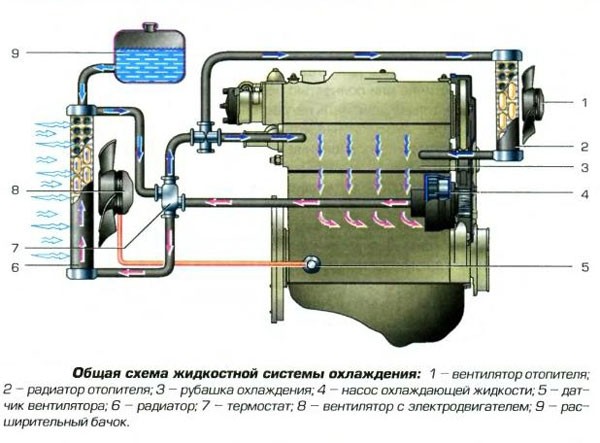
Engine cooling system: principle of operation and main components
Content
Your car's engine runs best at high temperatures. When the engine is cold, components wear out easily, more pollutants are emitted, and the engine becomes less efficient. Thus, another important task of the cooling system is fastest engine warm-up and then maintaining a constant engine temperature. The main function of the cooling system is to maintain the optimum operating temperature of the engine. If the cooling system, or any part of it, fails, the engine will overheat, which can lead to many serious problems.
Have you ever imagined what would happen if your engine cooling system didn't work properly? Overheating can cause head gaskets to explode and even crack cylinder blocks if the problem is severe enough. And all this heat must be fought. If heat is not removed from the engine, pistons are literally welded to the inside of the cylinders. Then you just need to throw away the engine and buy a new one. So, you should take care of the engine cooling system and find out how it works.
Cooling system components
Radiator
The radiator acts as a heat exchanger for the engine. It is usually made of aluminum and has a plurality of small diameter tubes with ribs attached to them. In addition, it exchanges the heat of the hot water coming from the engine with the surrounding air. It also has a drain plug, an inlet, a sealed cap, and an outlet.
water pump
As the coolant cools down after being in the radiator, the water pump directs fluid back to the cylinder block , heater core and cylinder head. In the end, the liquid again enters the radiator, where it cools again.
Thermostat
This is a thermostat, which acts as a valve for the coolant and only allows it to pass through the radiator when a certain temperature is exceeded. The thermostat contains paraffin, which expands at a certain temperature and opens at that temperature. The cooling system uses a thermostat to regulation of the normal operating temperature of the internal combustion engine. When the engine reaches standard operating temperature, the thermostat kicks in. Then the coolant can get into the radiator.
Other components
Freezing plugs: in fact, these are steel plugs designed to seal holes in the cylinder block and cylinder heads formed during the casting process. In frosty weather, they can pop out if there is no frost protection.
Head Gasket/Timing Cover: seals the main parts of the engine. Prevents mixing of oil, antifreeze and cylinder pressure.
Radiator overflow tank: this is a plastic tank that is usually installed next to the radiator and has an inlet connected to the radiator and one overflow hole. This is the same tank that you fill with water before the trip.
Hoses: A series of rubber hoses connect the radiator to the engine through which coolant flows. These hoses can also start to leak after a few years of use.
How the engine cooling system works
To explain how a cooling system works, you must first explain what it does. It's very simple - the car's cooling system cools the engine. But cooling this engine can seem like a daunting task, especially when you consider how much heat does a car engine produce. I think about it. The engine of a small car traveling at 50 miles per hour on a highway produces approximately 4000 explosions per minute.
Along with all the friction from moving parts, that's a lot of heat that needs to be concentrated in one place. Without an efficient cooling system, the engine will overheat and stop working within minutes. A modern cooling system should keep the car cool at an ambient temperature of 115 degrees and also warm in winter weather.
What's going on inside?
The cooling system works by constantly passing coolant through channels in the cylinder block. Coolant, driven by a water pump, is forced through the cylinder block. As the solution passes through these channels, it absorbs engine heat.
After leaving the engine, this heated liquid enters the radiator, where it is cooled by the air flow that enters through the car's radiator grille. Fluid is cooled as it passes through the radiator , going back to the engine again to pick up more engine heat and carry it away.
There is a thermostat between the radiator and the engine. temperature dependent The thermostat regulates what happens to the fluid. If the temperature of the fluid drops below a certain level, the solution bypasses the radiator and is instead directed back to the engine block. The coolant will continue to circulate until it reaches a certain temperature and opens the valve on the thermostat, allowing it to pass through the radiator again to cool.
It seems that due to the very high temperature of the engine, the coolant can easily reach the boiling point. However, the system is under pressure to prevent this from happening. When the system is under pressure, it is much more difficult for the coolant to reach its boiling point. However, sometimes pressure builds up and must be relieved before it can bleed air from the hose or gasket. The radiator cap relieves excess pressure and fluid, accumulating in the expansion tank. After cooling the liquid in the storage tank to an acceptable temperature, it is returned to the cooling system for recirculation.
Dolz, quality thermostats and water pumps for a good cooling system
Dolz is a European company that adheres to a set of standards for innovation, efficiency, reliability and sustainability in its worldwide sourcing solutions that help their partners and customers move water pumps where they are needed. With over 80 years of history, Industrias Dolz is world leader in water pumps with a wide range of products including distribution kits and thermostats for the production of spare parts. If you are interested in our products, please contact us and we will let you know.

